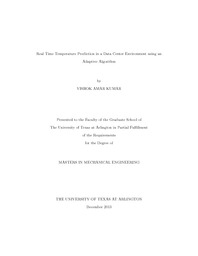
ATTENTION: The works hosted here are being migrated to a new repository that will consolidate resources, improve discoverability, and better show UTA's research impact on the global community. We will update authors as the migration progresses. Please see MavMatrix for more information.
Show simple item record
| dc.contributor.author | Amar Kumar, Vishok | en_US |
| dc.date.accessioned | 2014-03-12T23:49:15Z | |
| dc.date.available | 2014-03-12T23:49:15Z | |
| dc.date.issued | 2014-03-12 | |
| dc.date.submitted | January 2013 | en_US |
| dc.identifier.other | DISS-12494 | en_US |
| dc.identifier.uri | http://hdl.handle.net/10106/24083 | |
| dc.description.abstract | Most organizations around the world rely on information systems to run their operations. Data centers are hence a crucial aspect of most organizational operations to ensure business continuity. Disruption in the working of a system can impair the business largely and hence optimizing the environment in which the servers and storage devises of a data center are housed becomes extremely challenging. Most industries design the data center infrastructure to handle peak load conditions thus ensuring a continual functionality of its hosted environment. However, the cost of maintaining such a system is very high. This gives rise to the need of having a robust system which could regulate the energy consumption and thereby reduce the cost of maintaining these environments ,at the same time guaranteeing optimal performance. Standardization of such a system will yield savings and help improve the design of the facility. In the traditional approach, a CFD model is used to model the dynamic and complex environment of a data center. This system however takes a considerably long time to converge to a steady state hence causing loss of productive time and resources.We propose to solve these issues by using both a feed forward network and a dynamic recurrent artificial neural network which would mimic the functionality of the CFD , but at the same time guarantee a faster convergence rate and hence a better performance. Given a data center model with varying server heats and fan speeds ,our system is aimed to predict accurate temperature readings for the system ,hence ensuring controlled energy consumption in comparison to the traditional approaches. By using a recurrent system allowing time delays we incorporate the variables of a real time data center environment. Furthermore, the entire system is adaptive and hence the neural network would learn incrementally with every incoming data sample and use this error to better its performance. This guarantees an improvement of the system output and reduction in the prediction error with every incoming data sample as well as being scalable to model any room. This system is validated in against the results from the CFD and data from a static neural network for the same data center model. Various cases for different fan speeds and server heats have been tested and validated. This system can be incorporated to improve the control strategy for data centers. | en_US |
| dc.description.sponsorship | Bowling, Alan P. | en_US |
| dc.language.iso | en | en_US |
| dc.publisher | Mechanical Engineering | en_US |
| dc.title | Real Time Temperature Prediction In A Data Center Environment Using An Adaptive Algorithm | en_US |
| dc.type | M.S. | en_US |
| dc.contributor.committeeChair | Bowling, Alan P. | en_US |
| dc.degree.department | Mechanical Engineering | en_US |
| dc.degree.discipline | Mechanical Engineering | en_US |
| dc.degree.grantor | University of Texas at Arlington | en_US |
| dc.degree.level | masters | en_US |
| dc.degree.name | M.S. | en_US |
Files in this item
- Name:
- AMARKUMAR_uta_2502M_12494.pdf
- Size:
- 1.935Mb
- Format:
- PDF
This item appears in the following Collection(s)
Show simple item record


